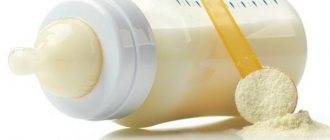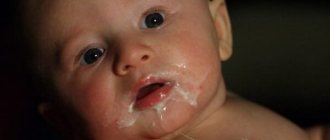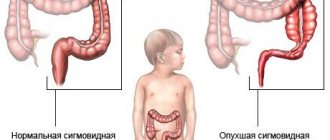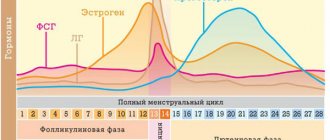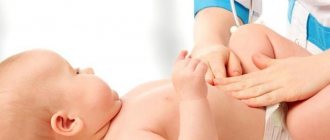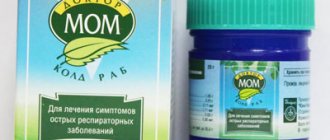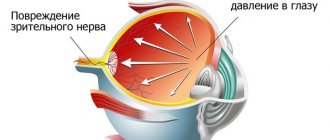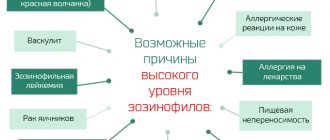Children who are breastfed or formula-fed occasionally experience burping. This symptom can frighten both the child and his parents. The baby is frightened due to temporary holding of breath and the feeling of discomfort in the digestive area.
And parents worry and wonder how normal such regurgitation is, how to get rid of it and when to contact a specialist. Knowing the answers to them, you can get rid of anxiety, because in most cases you can solve the problem on your own. The only exception is if the baby has a serious illness.
Causes of belching after feeding newborns
Belching is not the most pleasant, but quite normal symptom that is observed in people at any age. And in breastfed infants it is observed much more often. When bottle-fed, they involuntarily swallow too much air, which comes back out in two ways - in the form of intestinal gas or belching.
Other reasons for regurgitation in a baby include:
- overfeeding the baby, which causes the baby’s stomach to stretch;
- flatulence, characterized by excessive accumulation of gases in the children's intestines;
- too rapid change in the position of the child’s body from horizontal to vertical;
- tightly tied diapers and lack of rest in which the baby should be after feeding. It is not advisable to shake or tug a child who has eaten - just massage it a little and hold it in a certain position.
Other factors that contribute to the appearance of belching include intestinal obstruction, which occurs infrequently, but requires immediate attention to a specialist. The disease can be identified by the brown and green color of regurgitated milk (or mixture). After this, you should immediately call an ambulance.
They cause regurgitation and infectious diseases. Their signs are the presence of a large amount of undigested milk in the burp, high fever and pale skin. An additional symptom of this disease is the child’s refusal to eat. A sick baby should also be shown to a doctor, and based on the results of the examination, he may have to be hospitalized in an infectious diseases hospital. The same goes for problems with digestion and the gastrointestinal tract. If the reason is a disruption of the nervous system, you should contact a pediatric neurologist.
Characteristic signs
So how to distinguish vomiting from regurgitation in a baby? The characteristic signs of this phenomenon in children under one year of age are so vivid that it is almost impossible to confuse:
- the child does not gain weight;
- meals may be accompanied by difficulty breathing, the child screams and is nervous;
- convulsions appear;
- the fontanel protrudes and seems to swell a little;
- a sour smell appears from the baby’s mouth;
- the mass coming out also has a sour smell, bloody clots or yellowish spots (bile) may be observed in it;
- there is a clear disturbance of stool.
The practical difficulty of how to distinguish vomiting from regurgitation in an infant lies in the individuality of the child’s body. Since children react very differently to such phenomena, you should not think twice and try to justify the eruption of food with a good appetite. We urgently need to show the baby to the doctor and, together with him, choose tactics for further behavior.
How to distinguish belching from vomiting?
If the baby does not have any diseases, belching can be called a natural physiological process that does not require treatment. You should only be concerned when vomiting occurs - a complex reflex act characterized by the entry of stomach contents not only into the esophagus, but also into the oral cavity, and from there - out. This symptom is distinguished from belching by the following characteristics:
- unlike regurgitation, which begins only after feeding, vomiting is repeated repeatedly and regardless of food intake;
- vomiting is characterized by a yellowish tint resulting from the content of bile in the gastric juice;
- the volume of vomit is greater compared to belching.
Another difference between belching is the baby’s relatively good health. This symptom does not cause him much discomfort. However, if vomiting occurs, it is advisable to immediately go to the hospital for examination and appropriate treatment.
Other options
In a healthy child, regurgitation after feeding is a normal, physiological process associated with the release of excess gases from the intestines. Therapy will be required if belching turns into vomiting.
How to distinguish between simple release of excess air and gagging:
- Gases come out of the baby only after the feeding process. The occurrence of vomiting does not depend on the hours of nutrition or rest.
- Vomit is sometimes yellow in color because accumulated bile is released along with food.
- During burping, the amount of food leaving the newborn's stomach is small. When vomiting, the discharge is copious.
Any parent should remember: if symptoms of vomiting develop, you need to seek medical help as soon as possible to diagnose and prescribe adequate treatment.
Prevention of regurgitation
To prevent belching, it is recommended to feed the baby before he wants to eat and starts crying. It is best to determine the frequency of feeding if feeding is carried out according to a specific schedule. Preventing crying allows you to reduce the amount of air entering the body - belching will be weaker.
It is recommended to give the baby a massage, choose a suitable formula for feeding (if he is bottle-fed), and hold the baby correctly both during feeding and after.
Abdominal massage
Before feeding a baby, it is recommended to place the baby on his stomach on a hard surface and leave him there for a few minutes (no more than 5). Before the baby starts eating, it is advisable to give a small massage. To do this, with dry, clean hands, make several circular movements over the baby’s abdomen - in a clockwise direction, lightly pressing on the skin and periodically squeezing the baby’s legs towards the body.
The massage time is from 5 to 10 minutes. And it is best to do it through a warm and clean diaper. Such movements ensure the pushing of gases towards the rectum. And heat can reduce pain by relaxing the intestines.
Correct body and bottle position
For proper feeding without burping, the baby should be held in the correct position. The ideal option would be to bend the body at a right angle so that the head is higher than the stomach. And, if the position of the child lying down is traditional for a nursing mother, this habit will have to be changed. This position allows you to obtain the following advantages:
- liquid drains into the stomach;
- the air remains at the top;
- It is much easier for the baby to burp air bubbles caught in the milk.
If your baby is bottle-fed, it should be held upside down. It is also necessary to ensure that the milk fills the nipple completely, and that the baby wraps his lips around it as tightly as possible. In this way, you can prevent excess air from entering the child’s body and reduce the likelihood of burping.
Choosing a formula for your baby
The best choice for a baby is breast milk. However, if for some reason breastfeeding is not possible, it is recommended to choose a suitable formula. One that would not cause heartburn in the child.
If the artificial nutrition you are already using contributes to the appearance of regurgitation, you should consult a doctor. It is possible that a specialist will advise switching from a regular mixture to a medicinal one, which will reduce the frequency of belching or get rid of it completely. The most popular are drugs such as Frisova, Samper Lamolaka or Enfamila AR.
Amount of food
When considering problems with belching, some experts argue that the cause of the symptom is excess nutrition - that is, overeating. When breastfeeding, you practically never have to deal with this situation. The child's body adapts to nutrition with the help of the mother's breast, and independently chooses both the amount of milk consumed and the time of feeding.
With artificial feeding, the cause of belching can indeed be excess food. Although baby food manufacturers usually give recommendations on the volume of formula that should be given to babies at a time to avoid regurgitation. By sticking to them, you can avoid overfeeding.
After feeding
After finishing feeding your baby, you should not immediately let him take a horizontal position. It is advisable to hold the baby upright for at least 20 minutes. During this period, the baby will often burp the air pocket and some milk or formula will leak out of his mouth. When quickly changing position, the baby may experience frequent regurgitation.
The volume of belching may seem too large to the baby's mother. However, if the process of regurgitation itself corresponds to the normal state of the baby (the color of the discharge is white, it looks like milk), there is nothing to worry about. Around the seventh month, the baby's esophagus and stomach gradually adapt to feeding, and belching stops in most cases.
Precautions when holding a baby
If you do not allow your baby to burp and release air, he will have an attack of colic. The column pose has proven to be the most effective. Many people use horizontal position and massage.
It is worth taking precautions when holding a newborn in your arms. The body of a baby is very fragile, anything can happen. Bones and joints have a loose structure and are easy to damage. The child must be handled very carefully, especially in the first six months. Later, the baby begins to be active and tries to move independently.
What to do to avoid harming the baby:
- Constantly support the head, as it is difficult for children to hold it on their own. The cervical vertebrae are not strong enough.
- You cannot sit your baby in your arms, as this contributes to improper development of the spine.
- Any movement of the child should be smooth. The little ones are just beginning to get acquainted with the world and are quite shy.
- They take children out of the crib or lift them into the air, first of all, holding the neck, it is very fragile.
- You need to carry the baby in a column, holding it by the shoulder blades and lower back.
- In a horizontal position, the child’s head is placed on the elbow bolster, the baby’s body is supported with one hand, and the necessary manipulations are carried out with the other.
Important! You can lift your baby by pulling him by the arms until he is 6-8 months old. By this time, the baby is trying to sit up on his own. At an early age, this can damage the spine.
Mom in a blue jacket holds her child
Inducing burping after feeding
Sometimes the baby does not hiccup or burp at all. And the excess air is in his stomach, coming out gradually and causing discomfort. This leads to abdominal pain, which causes the baby to cry. This can be prevented by making sure that the baby burps immediately after feeding.
You can ensure belching by forcing it in the following way:
- Raise the baby to a vertical position so that his head is higher than the mother’s shoulder;
- Stroke the baby's back and press him to your stomach several times. Stroking allows you to induce belching a little faster than if it occurred naturally;
- If there is no regurgitation within a few minutes after eating, it is not necessary to continue to induce it artificially. It is possible that there will be no belching at all.
When feeding, the mother is required to be patient. Moreover, some babies may not burp at all, which is also a normal sign. There is no need to worry about this either - the absence of belching means that the baby does not have any pathologies, and his state of health does not cause concern.
First difficulties in the postpartum period.
But what you shouldn’t do with your baby after feeding is sudden movements. After eating, give him rest.
Do not shake the baby, do not play with him, and do not try to evoke a generous smile so that the child does not twitch sharply with a big sigh. Moreover, laughter in older infants can turn into prolonged hiccups or hysterics. It is often difficult to stop this, especially before bedtime, when the child’s nervous system is exhausted.
Let the food digest a little, don’t pump too much. Motion sickness is very useful, but there should be moderation in everything.
It is important to wean your baby from any motion sickness during a walk, or rather, do not accustom him to it. In the future, you will undoubtedly appreciate this advice of mine, especially in winter, even if you are skeptical about it at first.
If there is a need to urgently wash the baby or change his clothes during or immediately after feeding, then hold him at least a little in the manner described above to induce a burp, and only then take the necessary actions, but carefully.
Constant regurgitation in a newborn
If regurgitation continues not only after feeding, you should pay attention to the volume of belching and the frequency of urination in the baby. A normal indicator is considered if a child pees at least 12 times during the day. And the regurgitated mass is approximately equal to two tablespoons. You can compare the volume of belching with the permissible norm by the size of the spot. To do this, take water into a spoon and pour it onto the diaper next to the regurgitation marks.
Exceeding this indicator or belching too often is evidence of neurological problems or stomach diseases. This situation is dangerous not only because of the discomfort the child experiences, but also because of the lack of weight gain.
Due to constant burping, the baby does not receive enough nutrients and may lag behind in development. A way to solve the problem involves the use of special anti-reflux mixtures containing thickeners to increase the viscosity of the diet. Thick liquid enters the stomach and does not come back out during belching. However, it is best not only to switch to special feeding, but also to consult a doctor.
What is the norm
The norm is considered to be burping twice daily within a half-hour period after finishing feeding. Milk or curd discharge may contain saliva, and its smell may be sour. Wherein:
- weight gain has a positive trend;
- the baby, when vomiting a curdled mass, remains calm and cheerful, he has a good appetite;
- urine excretion occurs up to 10 times daily;
- the volume of gastric secretions does not exceed 2 tablespoons.
If a child can burp a lot and does it often, has poor sleep, rarely urinates, and does not gain weight, this is outside the normal range.
Important! When a baby spits up milk or curds during hours not associated with feeding, and there is bile or traces of blood in the secreted contents, you should immediately consult a specialist.
Seeing a doctor
Symptoms, the occurrence of which is considered a sufficient reason to consult a doctor, are:
- repeated refusal of the baby to feed;
- transition from belching to vomiting - when the liquid comes out not in separate portions, but in a fountain, and its color changes;
- lack of weight gain by the child.
In other situations, parents should simply monitor the baby’s condition and independently take measures to reduce the amount of regurgitation. If this does not help, you should still contact your pediatrician. Sometimes it is better to be safe than to miss the onset of a serious illness.
The specialist may prescribe medications to the baby to improve intestinal motility such as Coordinax or Motilium. Taking them leads to improved intestinal function and most often improves the child’s condition. But, if the reasons for frequent regurgitation are more serious, surgical intervention may be necessary to solve the problem.
Doctor Komarovsky's opinion
Dr. Komarovsky, known to many, does not see any problems for the baby in such a physiological process. He considers regurgitation absolutely normal if the weight increases at the same time. Frequent regurgitation is a signal of overeating. The doctor reminds: the stomach has a certain capacity, sometimes the amount of milk consumed exceeds it, and the excess must come back out. Another circumstance that Komarovsky mentions is swallowed air and the predominantly recumbent position of the newborn. At the age of approximately 6-7 months, the child begins to sit, and the frequency of regurgitation decreases.

